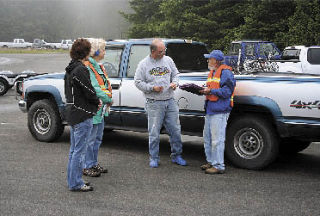Whether they were Red Rock or Dungeness crabs, anglers were having good success at Cornet Bay early Wednesday morning on the foggy opening day of Whidbey Island’s 2008 crabbing season.
Scores of people were out on the water and the marina’s parking lot was full of empty boat trailers, but nearly as many folks were having luck using crab rings and fishing right off the docks.
Catching the tasty decapods wasn’t the only activity going on as the sun attempted to burn the fog off and warm things up a bit.
Funded in part by the National Fish and Wildlife Foundation and organizations such as the NOAA Marine Debris Grant Program, the Tulaip Tribes and the Seaworld Busch Gardens Conservation Fund, among others, members of the Whidbey Island Beach Watchers were hard at work handing out information and taking surveys.
Under the direction of Sarah Martin, Beach Watcher Coordinator for Island County, Ingri Johnson and Mahmoud Abdel-Monem were passing out samples of crab escape cords and talking to anglers about what type of gear they were using and whether they had lost any pots in past years.
Information Martin and her colleagues were giving out indicated that an estimated 372,000 crabs die in lost pots each year in the Northwest Straits.
“If crabbers used the escape cords, which are made of cotton thread and biodegradable, the crabs inside a lost pot will be able to get out and other crabs wouldn’t be able to get in,” Johnston said.
Officials estimate that a lost pot may catch and kill as many as 75 crabs in a year.
“We have had eight boats willing to talk to us and do surveys,” Abdel-Monem, who is from Egypt, but has lived in Oak Harbor for the past three years, said. “We have
distributed the crab escape cords to about a dozen people.”
Abdel-Monem said some questions on the survey asked how many pots the anglers were using, how many pots had escape cords, have they used escape cords in the past, would they use the cords in the future and have they lost any pots.
“Four of the people I talked to said they have lost pots in past years,” Abdel-Monem said.
Anacortes resident Keith Rubin, one of the crabbers the watcher’s group interviewed, said he plans
on getting out and catching some crabs today and thought the escape cords were a good idea.
“I’d like to catch a few, that is if we don’t get lost in the fog,” he said.
Adjacent to the boat ramp, Tom Horton from Oak Harbor and a member of Boy Scout Troop 144, along with his friend, Lucas Salmons, were passing out information on invasive tunicates of Washington state and also taking a survey on peoples’ knowledge of the marine inhabitants.
“We’re helping out our friend,
Mark Fouts, with his Eagle Scout project,” Horton said. “He is also a member of troop 144 and he is up by the marina doing the same thing that we are.”
Tunicates, both native and non-native, have been ranked as one of the most devastating ecological impacts to affect marine and fresh waters. Once established, they are difficult to control and the non-native species are often impossible to eradicate.
The scouts were conducting an informational campaign to make people aware and what they can do to help control the growing problem.
Along the dock, Joe Perkins from Leavenworth was in his boat packing bait containers with chicken parts and getting ready to head out and drop some pots.
Perkins was receiving “supervisory” assistance during the baiting process by his dog, Scooter
Magoo.
“All of our dogs have two names,” Perkins’ wife, Laurie said. “Scooter Magoo is a veteran crab dog and loves to go out in the boat.”
Further down the dock, Ed Nance from Oak Harbor said he’d caught a few of Red Rocks off the dock using a crab ring.
“My buddy down the way, he pulled in a bunch of them this morning,” he said.
Nance said he didn’t remember what his buddy’s name was. “He’s just my fishin’ buddy,” he said.
Also having success off the dock using crab rings were Jeffrey Morris and Adam Erickson, both members of VAQ 129, stationed at NAS Whidbey Island.
Morris, from Virginia, who said he works on weekends, and Erickson, a native of Des Moines, Iowa, who said he was on vacation, reported they were have pretty good luck so far.
“When we started out this morning, we’d let the ring soak for only about 10 minutes and we were able to catch some,” Erickson said. “We caught a bunch of Red Rocks and one Dungeness that my buddy threw back in. That’s okay, though, we’re learning and didn’t know what it looked like.”
Some of the younger kids had small bait containers attached to the lines on their fishing poles and were dipping them in the water in hopes of a crab coming along and grabbing on to the bait container.
“It works if you can reel them in fast enough,” one of the young anglers said.
Crabbing continues in areas 8-1 and 8-2 on a Wednesday through Saturday schedule until Sept. 1. Crab fishing is also open the the areas the entire Labor Day weekend, Aug. 30 to Sept. 1.


